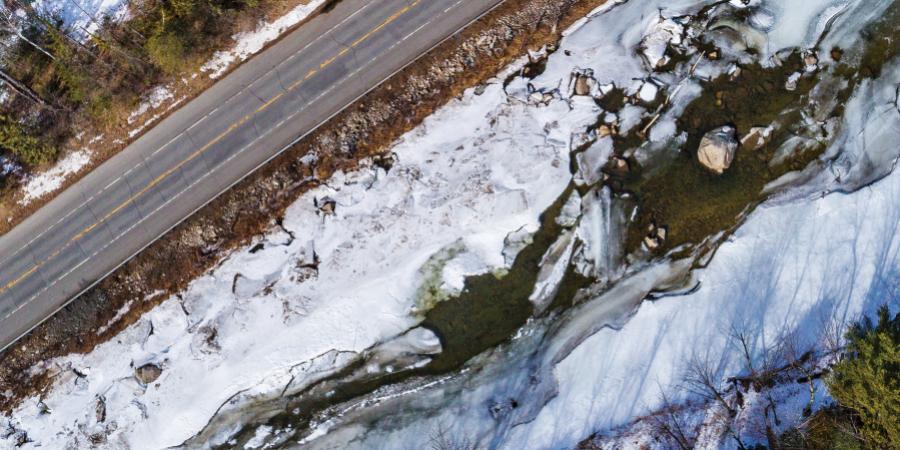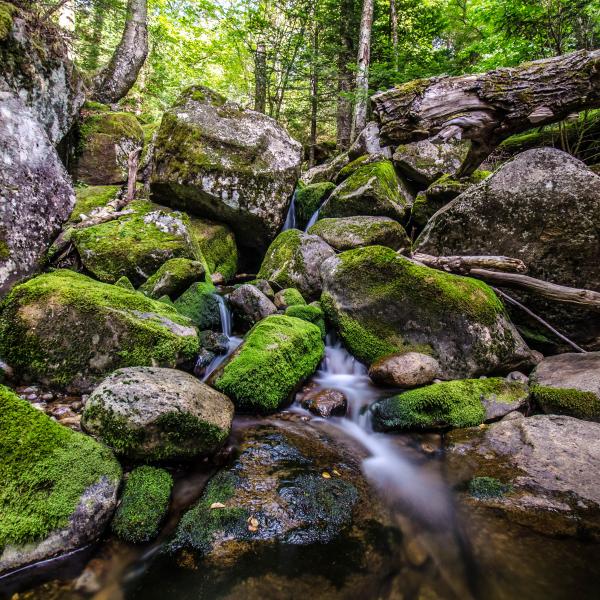Reducing Salt Use
For homeowners and road managers, winter means applying salt (typically sodium chloride) to roads, driveways, and sidewalks. Salt is a pollutant in our freshwater lakes and rivers that significantly degrades water quality and, in turn, threatens sensitive aquatic species and drinking water sources. Testing has revealed that several waterbodies in the Ausable watershed have high levels of chloride, the effects of which are being monitored by AsRA and others.
To reduce or eliminate the need for salt, stay on top of snow removal. Shovel, plow, or blow the snow soon after it has fallen to prevent it from sticking to sidewalks or pavement. If you need to use salt, try mixing a small amount with an abrasive material like sand to give traction or use alternatives to rock salt such as liquid salt or an ice melter (calcium magnesium acetate). You can also discuss your concerns about salt applied to public roadways by contacting your town, county, and state representatives or by attending public meetings.
Managing Stormwater
In a natural setting, precipitation and melt water are slowed by vegetation or collected in wetlands where it can be absorbed and filtered by the soil, reducing flood impacts, improving water quality, and recharging aquifers. Stormwater runoff from roads, driveways, parking lots, rooftops, and other impervious surfaces collects and moves quickly, often with greater force than the precipitation it collects, eroding soils and picking up sediment, debris, and pollutants as it makes its way to local streams, wetlands, and lakes.
Work to reduce impervious surfaces on your property. See page 25 in our printed publication for ideas on how to increase runoff absorption on your land, minimizing turf grass and planting dense buffers of native grasses, shrubs, and trees. Identify and manage sources of pollution that can be transported by runoff such as a faulty septic system, fertilizer, and pesticide use, leaking automobile fluids, and rock salt for winter maintenance.
Rain Gardens & Stormwater Planters
A rain garden is a shallow depression in your lawn or garden that is planted with native plants and captures runoff from a roof downspout, patio, or walkway. When correctly built, rain gardens can protect streams, lakes, and landscaping from the damaging effects of storm runoff. They are aesthetically pleasing, provide water for diverse plantings, and attract hummingbirds and butterflies to your yard.
While grass is a step up from a paved surface, mostturf grass has shallow roots that cannot absorb the same amount of water as native plants. Native plant rain gardens planted in organic soils can treat up to 1,000 square feet of drainage area per rain garden. In urbanized areas, stormwater planters can be built over paved surfaces and connected to downspouts to capture runoff from buildings, pavement, and rocky areas. Numerous manuals exist online, including the New York State Stormwater Management Design Manual (Chapter 5) and the Vermont Rain Garden Manual.
Moving from Impervious to Permeable
Impervious surfaces such as roads, sidewalks, driveways, and roofs do not absorb precipitation and runoff. High proportions of impervious surfaces are directly related to water quality degradation. Permeable pavement and surfaces allow infiltration of precipitation and runoff. Infiltration maintains the natural hydrology of the watershed, allowing aquifers to be recharged, improving water quality, and protecting downstream areas from flooding.
Talk to your town or county representatives about using permeable pavement options for parking lots or sidewalks. If you are constructing a new driveway or parking area, or your current one needs an upgrade, consider using porous options such as gravel, interlocking pavers, or crushed stone which allow some infiltration. For even more infiltration, use interlocking pavers with spaces between the units that allow grass to grow.



